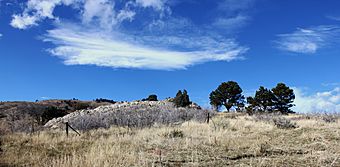Magic Mountain Site facts for kids
The Magic Mountain Site is a really old village site in Jefferson County, Colorado. People lived here a very long time ago, from about 4999 BC to 1000 AD. This means it was used during the Archaic and Woodland periods.
In 1980, this important place was added to the National Register of Historic Places. It got its name from the Magic Mountain Amusement Park, which owned the land in the late 1950s. A hundred years before that, the area was known for mining and had a small stop for stagecoaches.
Contents
Exploring the Magic Mountain Site's Location
The Magic Mountain Site is found in the foothills of the Rocky Mountains. It sits in an area called the Denver Basin, right by Apex Creek. This spot is special because it's where the mountains meet the plains. It's a mix of different natural environments.
A Journey Through Time at Magic Mountain
In the Denver Basin, experts divide prehistoric times into three main periods. These are the Paleo-Indian, Archaic, and Ceramic (or Woodland period) times. The Denver Basin is a large area of land in Colorado. It stretches from Colorado Springs, Colorado, all the way to Wyoming.
Life During the Archaic Periods
People living in the Archaic were skilled hunters and gatherers. They hunted smaller animals like deer, antelope, and rabbits. They also collected wild plants to eat. These groups moved around with the seasons, following food sources.
Later in the Archaic period, around 200 to 500 AD, something new happened. People started growing corn, and they learned to make pottery. Pottery was very useful for storing and carrying food.
The Colorado Plains Woodland Culture
During the Woodland period, groups of people became more settled. They often lived in one or two main places. They began to farm and raise animals. They also made pottery and baskets, which helped them store things. This period also saw more complex ceremonies and rituals.
Uncovering History: Archaeology at Magic Mountain
Archaeologists study old sites to learn about the past. The Magic Mountain Site has taught us a lot about the Archaic and Woodland cultures.
Tools and Artifacts Found
Many stone tools and projectile points were found here. These tools helped experts understand how people lived. Some special spear points found were named "Apex points." They were similar to points found in New Mexico.
Archaeologists dug down and found six different layers of history. They called these layers Zones A through F. Each zone tells us about a different time period and the people who lived there.
| Time Period | Years | Cultures |
|---|---|---|
| Early Archaic | 4050-3050 BC | Zone F. Mount Albion complex. |
| Early Archaic | 3050-2050 BC | Zone E. Magic Mountain complex. |
| Middle Archaic | 1550 - 810 BC | Zone D. Apex complex. |
| Late Archaic | 810 BC - AD 100 | Zone C. Front Range phase. |
| Colorado Plains Woodland culture. | AD 100 - 1000 | Zone B. South Platte phase. |
| Colorado Plains Woodland culture. | AD 100 - 1000 | Zone A. South Platte phase. |
Some artifacts from the Fremont culture were also found in Zone A. This suggests that people traded goods with other groups. A small burial area was found, which led to the discovery of the site. Sadly, some parts of the site were disturbed before proper excavations could begin.
Digging Up the Past: Excavations
Many different groups have worked to uncover the secrets of Magic Mountain.
| Date | Name | What Happened |
|---|---|---|
| 1956 | Regional studies. | Initial surveys of the area. |
| 1959–1960 | Cynthia Irwin-Williams, Peabody Museum of Harvard University | Three burials were discovered. Her findings were later published in a book. |
| 1994 & 1996 | Centennial Archaeology LLC | Further archaeological work. |
| 2017-2018 | Paleocultural Research Group and Denver Museum of Nature and Science | Recent studies and digs. |
Where the Artifacts Are Now
In 2001, about 2,500 artifacts from the Magic Mountain archaeological site were moved. They are now kept at the Denver Museum of Nature and Science.
Why Magic Mountain is Important
The Magic Mountain Site is very special because it has so many artifacts from the Early, Middle, and Late Archaic periods. It also has burial sites and shows a history of different cultures living in the area. It helps us understand how people lived thousands of years ago in Colorado.


